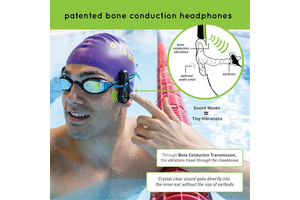Swimming is a wonderful way to keep fit but the equipment you use can make you faster.
Nov 24, 2019

Swimming is one of the best ways to get, and stay, in shape. But why do professional swimmers wear such tight-fitting suits?
Here we explore the science behind them and reveal how much of an impact high-tech suits can make to a swimmer's performance.
Why do swimmers wear tight suits?
Swimming suits are primarily designed to not only preserve your dignity but also help you swim more efficiently. The main problem to overcome when moving through the water is something called drag.
You experience drag all the time, but in the air, it is easily overcome when walking or running. If you want to feel how strong drag can be in the air, hold your hand (obviously be careful) out of the window in a moving car.
That backward force imparted on your hand is drag in action. And it can be surprisingly strong.
This is a basic component of fluid dynamics and engineers work tirelessly to make vehicle, ship and aircraft designs in such a fashion as to reduce its impact.
When the medium is denser, like water, drag becomes more of a problem when trying to move through it. Water is pretty sticky and at higher speeds can be a serious problem for any sea vessel.
For swimmers, water effectively pushes back on them as they attempt to push through it. Not only that, but a small wave (bow wave) is produced in front of the swimmer adding to the impact of drag.
For swimmers, even a small improvement in drag resistance can be a game-changer in competitions. So much so, in fact, that after the 2009 World Swimming Championship, Speedo's LZR suits were effectively banned by FINA in 2010.
Apart from the very high tech solutions devised by companies like FINIS, Speedo, ARENA….. even regular swimsuits can help improve swimmer performance in the water.
One of the reasons that swimsuits are tight to the body is to help control the shape of the wearer's body. It effectively helps to make them more hydrodynamic.
Higher quality suits are also made of special materials that repel water multiplying the suit's ability to reduce drag. What is interesting is that you don't even need to be an Olympian to notice the difference.
If you wore one it is highly likely you'd make a better time per lap than just wearing trunks or swim shorts (as a man).
How do swimsuits make you swim faster?
We've already touched on one quality of swimsuits that help you swim faster - they are tight to the body. This helps them make you more streamlined in the water.
Many professional swimmers will also shave most of the hair on their body to further reduce drag in the water. Caps are usually also worn to cover their heads and keep their ears tucked in.
But the tightness of swimsuits can also help reduce the build-up of lactic acid in your muscles. Lactic acid is the main culprit for your muscles feeling tired, or getting a stitch when you perform an aerobic exercise like swimming.
But swimsuits can do a lot more than that.
High-quality ones tend to be made from specially designed materials that provide small, but significant, advantages over less expensive alternatives.
Most swimsuits today tend to be made from nylon or spandex. Both of these synthetic fibers not only help make the suit tight but are also hydrophobic in nature. This property enables them to be water-resistant which can reduce the effects of drag by as much as 8%.
They, in effect, repel water away from them helping the swimmer better "cut" through a body of water.
Their seams are also specially designed to help improve swimming efficiency. The way that the materials are held together in the final suit can also play a vital role.
Bonded, rather than sewn seams can help reduce drag by as much as 6%. Pretty impressive.
Some of the most advanced suits even attempt to mimic the dermal denticles of sharks. This further enhances their ability to reduce drag and increase speed.
Click here for the full article


















